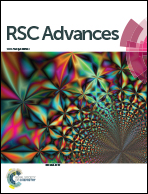Light-induced structural changes during early photo-intermediates of the eubacterial Cl− pump Fulvimarina rhodopsin observed by FTIR difference spectroscopy†
Abstract
Fulvimarina pelagi rhodopsin (FR) is a member of inward eubacterial light-activated Cl− translocating rhodopsins (ClR) that were found recently in marine bacteria. Here, we present the first detailed low-temperature FTIR difference spectroscopy analyses assisted with static UV-visible spectroscopy on this novel ClR, monitoring its FRK and FRL-like (FRL′) intermediates at 77 and 220 K, respectively. Light-activated FTIR difference spectra in the fingerprint C–C bands (1290–1040 cm−1) and the hydrogen-out-of-plane (HOOP) wagging vibrations of the retinal chromophore indicate similar but not identical configurations of the FRK and FRL′, and that the retinal undergoes all-trans to 13-cis isomerization upon photo-activation similar to other microbial rhodopsins. Further, the analysis of the C![[double bond, length as m-dash]](https://www.rsc.org/images/entities/char_e001.gif) C ethylenic vibrations reveal that FRK and FRL′ states are red-shifted from the unphotolyzed state. Light-induced FTIR difference spectral analyses of the amide I and amide II regions (1700−1560 cm−1) of the protein moiety, further suggest that FR undergoes large protein rearrangements during the primary states of photo-activation. In addition, we tentatively assign the bands at 1628 (−)/1618 (+) cm−1 to the C
C ethylenic vibrations reveal that FRK and FRL′ states are red-shifted from the unphotolyzed state. Light-induced FTIR difference spectral analyses of the amide I and amide II regions (1700−1560 cm−1) of the protein moiety, further suggest that FR undergoes large protein rearrangements during the primary states of photo-activation. In addition, we tentatively assign the bands at 1628 (−)/1618 (+) cm−1 to the C![[double bond, length as m-dash]](https://www.rsc.org/images/entities/char_e001.gif) N stretching vibrations, that is ∼6 (−)/3 (+) cm−1 downshifted from its archaeal counterpart halorhodopsin. This assignment reveals that FR undergoes no changes in the C
N stretching vibrations, that is ∼6 (−)/3 (+) cm−1 downshifted from its archaeal counterpart halorhodopsin. This assignment reveals that FR undergoes no changes in the C![[double bond, length as m-dash]](https://www.rsc.org/images/entities/char_e001.gif) N stretch upon FRL′-formation, suggesting similar hydrogen-bonding and Schiff base environments between FRK and FRL′.
N stretch upon FRL′-formation, suggesting similar hydrogen-bonding and Schiff base environments between FRK and FRL′.


 Please wait while we load your content...
Please wait while we load your content...